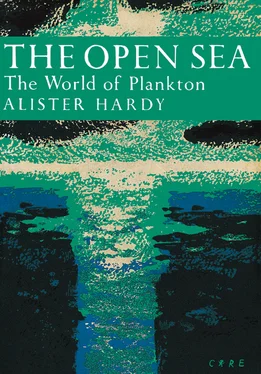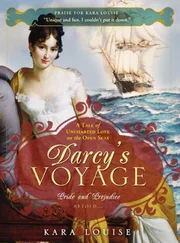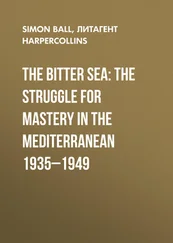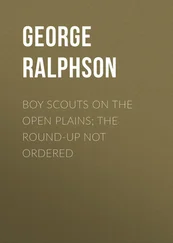With no less gratitude, I must make acknowledgments regarding the text. Apart from the more normal editorial comments and suggestions I particularly want to say how much I am indebted to my old friend—and once Oxford tutor—Dr. Julian Huxley, who read the whole book with the greatest care and made many valuable suggestions for its improvement. My typescript—how reminiscent of my undergraduate essays of 1919 and ’20!—was covered with his pencilled scribblings in the margin: “Surely you should refer to—, this might be made more emphatic” and the like; not all were adopted, but certainly a great many. The chapter on water movements was read by Dr. G. E. R. Deacon, and that on squids and cuttlefish by Dr. W.J. Rees; I am indeed grateful to them for a number of helpful suggestions they kindly made.
Finally I wish to draw the attention of those who are not scientists to a glossary at the end of the book giving a simple explanation of the few technical terms which have been unavoidably used; and for the zoologist I would point out that the authorities for the different specific names will be found quoted after these names in the index and not in the text where they are left out to avoid undue elaboration.
A.C.H.
THERE is a very simple fact about the sea which makes its inhabitants seem even more remote from us than can entirely be accounted for by their being largely out of sight. To make my point allow me to imagine a world just a little different from our own.
Suppose for a moment that we live in a country which is bounded on one side by a permanent bank of fog. It is a grey-green vapour, denser even than that often known as a London particular, and it has a boundary as definite as the surface of a cloud so that it is like a curtain hanging from the sky to meet the ground; we cannot enter it without special aids except for a momentary plunge and as quickly out again for breath. We can see into it for only a very little way, but what we do see is all the more tantalizing because we know it must be just a glimpse—a tiny fraction—of all that lies beyond. We find it has life in it as abundant as that of our own country-side, but so different that it might be life from another world. No insects dwell beyond the barrier, but other jointed-legged creatures take their place. Unfamiliar floating forms, like living parachutes with trailing tentacles, show their beauty and all too quickly fade from view; then sometimes at night the darkness may be spangled with moving points of light—living sparks that dart and dance before our eyes. Occasionally gigantic monsters, equal in size to several elephants rolled into one, blunder through the curtain and lie dying on our land.
To make a reality of this little flight of fancy all we have to do is to swing this barrier through a right-angle so that it becomes the surface of the sea. How much more curious about its unfamiliar creatures many of us might be if the sea were in fact separated from us by a vertical screen—over the garden wall as it were—instead of lying beneath us under a watery floor. Who as a child has not envied the Israelites as they passed through the Red Sea as if marching through a continuous aquarium: “and the waters were a wall unto them on their right hand, and on their left.”? What might they not have seen? Because normally our line of vision stretches out across the sea to the skyline and carries our thoughts to other lands beyond, many of us tend to overlook this perhaps more wonderful realm beneath us, or we seem to think it must be too difficult of access ever to become a field for our exploration or delight.
The aim of this book is to give the general reader an account of the natural history of the open sea around our islands and at the same time show how he may, with only modest equipment, see something of this strange world for himself. The amateur naturalist afloat—whether on a yachting cruise, on a fishing vessel, or just out in a rowing boat—may see much if he has the right kind of quite simple gear and knows how to use it; he may perhaps also be lucky and make original observations which will be a contribution towards finding an answer to one of the many unsolved riddles of the sea. The book will also give a sketch of some of the factors upon which the success of our great sea fisheries depend. The lives of the different fish are like threads woven in a web of life—a network of inter-relationships between many various creatures large and small, as complex as any on the land. The story of fishery research, which belongs mainly to our subsequent volume, is so closely linked with this unseen web, that it is hoped an account of these less familiar animals may be as interesting to the fishermen as to the naturalist; indeed many fishermen are naturalists and have much of importance to tell the scientist.
As our title indicates, the book will deal with the open sea—the sea beyond the coastal waters. The life of the intertidal zone has already been beautifully treated in this series of volumes by my friend Maurice (C. M.) Yonge (1949). The sea-shore can be studied by direct observation as the tide recedes and has long been a happy hunting-ground for the naturalist; he can lift up the fronds of seaweed, turn over stones, probe into rock-pools and dig into the sand and mud. Our methods of studying the life of the open sea must be very different; it is far from ‘open’ to the investigator, being in fact a hidden world, but this makes its exploration all the more exciting. Deep-sea photographic and television cameras are important new developments which promise much for the future; they, however, as also submarine observation chambers like the bathysphere, must for some time to come be regarded as very costly and specialist equipment giving us here and there direct confirmation of what we usually have to find out by other means. The diving helmet and the aqualung may help us to see something of this enchanting world in shallow water, but for the discovery of what is happening over wide stretches of the underwaters of the open sea we must devise more indirect methods.
The fact that we can see only a very little way below the surface indicates a property of water, and particularly of the sea, which is of fundamental importance to the life it contains. Held up in a glass, water appears so very transparent that we are at first surprised to find how quickly light is absorbed in the sea itself and what a little distance its rays will penetrate. Measurements made in the English Channel off Plymouth show that at a depth of five metres (just over 16 feet) the intensity of light is less than half that just below the surface, while at 25 metres it is only an insignificant fraction, varying between 1½ and 3 per cent. This at once tells us that the green plants, which must have sunlight in order to live, will only be found in the upper layers of the water.
The one real difference, of course, between animals and plants is a matter of their mode of feeding. We know that an animal of any kind, whether mammal, fish, shrimp, or worm, must have what we call organic food: proteins, carbohydrates (sugars, starches and the like) and fats, which have been built up in the bodies of other animals or plants. One animal may feed upon another kind of animal which in turn may have lived upon other kinds, and perhaps these upon yet others, but always these food-chains, long or short, must begin with animals feeding upon plants. Only the green plants, with that remarkable substance chlorophyll acting as an agent, can build themselves up from the simple inorganic substances by their power of using the energy of sunlight (photosynthesis); they split up the molecules of carbon dioxide, liberate the oxygen, and combine the carbon with the oxygen and hydrogen of water to form simple carbohydrates, which are then elaborated into more complex compounds by being combined with various minerals in solution. On the land we are all familiar with this elementary fact of natural history; my reason for recalling it is to emphasise that it is of universal application. The plants are the producers and the animals the consumers as much in the sea as on the land. Indeed ‘ all flesh is grass’.
Читать дальше












